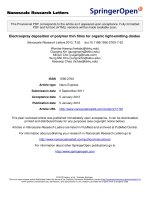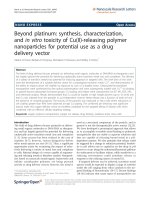- Trang chủ >>
- Khoa Học Tự Nhiên >>
- Vật lý
nanoscale particles for polymer degradation
Bạn đang xem bản rút gọn của tài liệu. Xem và tải ngay bản đầy đủ của tài liệu tại đây (3.43 MB, 143 trang )
Accepted Manuscript
Title: Nanoscale Particles for Polymer Degradation and
Stabilization – Trends and Future Perspectives
Authors: Annamalai Pratheep Kumar, Dilip Depan, Namrata
Singh Tomer, Raj Pal Singh
PII: S0079-6700(09)00011-2
DOI: doi:10.1016/j.progpolymsci.2009.01.002
Reference: JPPS 573
To appear in: Progress in Polymer Science
Received date: 6-1-2008
Revised date: 13-1-2009
Accepted date: 14-1-2009
Please cite this article as: Kumar AP, Depan D, Tomer NS, Singh RP, Nanoscale Particles
for Polymer Degradation and Stabilization – Trends and Future Perspectives, Progress
in Polymer Science (2008), doi:10.1016/j.progpolymsci.2009.01.002
This is a PDF file of an unedited manuscript that has been accepted for publication.
As a service to our customers we are providing this early version of the manuscript.
The manuscript will undergo copyediting, typesetting, and review of the resulting proof
before it is published in its final form. Please note that during the production process
errors may be discovered which could affect the content, and all legal disclaimers that
apply to the journal pertain.
1
Nanoscale Particles for Polymer Degradation and Stabilization – Trends
and Future Perspectives
Annamalai Pratheep Kumar
1
, Dilip Depan
1
, Namrata Singh Tomer
2
and Raj Pal Singh
1
∗
1
Polymer Science and Engineering Division
National Chemical Laboratory, Pune-411008, India
E-mail:
Telephone: +91-20-25902091, Fax: +91-20-25902615
2
Department of Chemical & Biomolecular Engineering
Clemson University, Clemson, SC 29634-0909, USA
Abstract
The field of nanoscience and nanotechnology is extending the applications of
physics, chemistry, biology, engineering and technology into previously unapproached
infinitesimal length scales. The polymer – nanoparticles / nanocomposites have been the
exponentially growing field of research for developing the materials in last few decades
and have been mainly focusing on the structure-property relationships and their
development. Since the polymer-nanocomposites have been the staple of modern
polymer industry, their durability under various environmental conditions and
degradability after their service life are also essential fields of research. Thus, this article
is intended to review the status of worldwide research in this aspect. Among various
nanoparticulates, clay minerals and carbon nanotubes are more often used in enhancing
physical, mechanical and thermal properties of polymers. In very few systems, the
nanoparticulates have been incorporated into polymer as ‘nano-additives’ for both
purposes: degradation and stabilization of polymers. The degradation and durability of
polymers is reviewed in the presence of nanoparticles / nanocomposites under different
environmental conditions. Nanoparticle -induced biodegradation of polymers is also
discussed.
∗
Corresponding author
2
Key words: Polymer, nanoparticles, clay, carbon nanotubes, metal oxides,
nanocomposites, degradation and stabilization.
3
Contents
1. Introduction
1.1. Definitions
1.2. Various classifications of polymeric nanomaterials
1.2.1. Nanoparticles
1.2.2. Nanocomposites
1.3. Growth and Significance
2. Preparation and processing of polymeric nanomaterials
2.1. Nanocomposites based on layers
2.2. Nanocomposites based on nanotubes
2.2.1. Carbon nanotubes
2.2.2. Cellulose whiskers
2.2.3. Inorganic nanotubes/nanofibers
2.3. Nanocomposites using nanoparticles
2.3.1. Synthesis of nanoparticles: Nucleation and growth
2.3.2. Preparation methods
2.4. Characterization of nanoparticulates and nanocomposites
3. Degradability and durability of Polymers: Overview
4. Degradation of polymeric nanomaterials
4.1. Photo-degradation and stabilization
4.1.1. Nanocomposites based on nanolayers
4.1.1.1.Polyolefins
4.1.1.2.Polyacrylates
4.1.1.3.Polyesters
4.1.1.4.Polycarbonates
4.1.1.5.Polyamides
4.1.2. Nanocomposites based on nanotubes / nanofibers
4.1.3. Nanocomposites based on nanoparticles
4.2. Thermal degradation and stabilization
4.2.1. Nanocomposites based on nanolayers
4.2.1.1.Polyolefins
4.2.1.2.Ethylene vinyl acetate copolymer
4.2.1.3.Polyacrylates
4.2.1.4.Polyesters
4.2.1.5.Polycarbonates
4.2.1.6.Polyamides and polyimides
4.2.1.6.1. Polyamides
4.2.1.6.2. Polyimides
4.2.1.7.Epoxy Polymers
4.2.1.8.Polyethers/ Polyurethanes/ Silicon rubbers
4.2.1.9.Miscellaneous
4.2.2. Nanocomposites based on nanotubes / nanofibers
4
4.2.3. Nanocomposites based on nanoparticles
4.3. Biodegradation and stabilization
4.3.1. Nanocomposites of biodegradable polymers
4.3.1.1.Biopolymers as matrix
4.3.1.2.Biopolymers as fillers
4.3.2. Nanocomposites of non-biodegradable polymers
4.4. Other factors
4.5. Advantages over conventional additives (stabilizers/ sensitizers)
5. Future perspectives
5.1. Road to new polymer-nanoparticulates systems
5.2. Importance for studying durability /degradability
5.3. Need of new stabilizing systems
6. Conclusions
Acknowledgement
Reference
5
Abbreviations
µm Micrometre
AAGR Average Annual Growth Rate
AGU Anhydroglucose Unit
ATH Aluminium trihydroxides
BZD Benzidine
CMC Critical Micelle Concentration
CNT Carbon Nanotubes
CVD Chemical Vapour Deposition
DMA Dynamo Mechanical Analysis
DNA Deoxyribose Nucleic Acid
DP Degree of Polymerization
DSC Differential Scanning Calorimetry
EPDM Ethylene-Propylene Diene Monomer
EVA Ethylene Vinyl Acetate Copolymer
FTIR Fourier Transform Infra Red
GPC Gel-Permeation Chromatography
HAP Hydroxyapatite
LDH Layered double Hydroxides
LDPE Low Density Polyethylene
LLDPE Linear Low Density Polyethylene
MMT Montmorillonite
MWCNT Multi-walled Carbon Nanotubes
NC Nanocrystal
nm Nanometre
NMR Nuclear Magnetic Resonance
NSP Nano scale particles
OATP Organo Attapulgite
OMMT Organically Modified Montmorillonite
PBT Polybutylene Terphthalate
PC Polycarbonate
PE Polyethylene
PLA Polylactic Acid
PMMA Polymethyl Methacrylate
PP Polypropylene
PU Polyurethane
PVD Physical Vapour Deposition
SAXS Small Angle X-Ray Scattering
SEM Scanning Electron Microscopy
SPHERE Simulated photodegradation of high-energy radiant exposure
SWCNT Single-walled Carbon Nanotubes
TEM Transmission Electron Microscopy
T
g
Glass Transition Temperature
TGA Thermogravimetric Analysis
TMDS Tetramethyl disiloxane
USAXS Ultra Small X-Ray Scattering Spectroscopy
6
UV Ultraviolet
WAXD Wide Angle X-Ray Diffraction
XPS X-Ray Photo Electron Spectroscopy
XRD X-Ray Diffraction
7
1. Introduction
The field of nanoscience and nanotechnology which deals with materials and structures
having dimensions that measure up to billionth of a meter (nanometer) is extending the
applications of physics, chemistry, biology, engineering and technology into previously
unapproached infinitesimal length scales. Now, at nanoscale one enters a world where
physics and chemistry meet and develop novel properties of matter. In chemistry, this
range of sizes has historically been associated with colloids, micelles, polymer molecules,
phase-separated regions of block copolymers and similar structures. More recently,
structures such as buckytubes, silicon nanorods, and compound semiconductor quantum
dots have emerged as particularly interesting classes of nanostructures. In physics and
electrical engineering, nanoscience is most often associated with quantum behavior, and
the behavior of electrons and photons in nanoscale structures. Biology and biochemistry
also have a deep interest in nanostructures as components of the cell; many of the most
interesting structures in biology - from DNA and viruses to subcellular organelles and
gap junctions can be considered as nanostructures [1-2]. Recently, Whitesides [3]
discussed the reasons for the fascination and growth of this inter- / multi-disciplinary
research. According to Braun et. al. [4], from 1980s, the growth of research papers
dealing with the prefix called ‘nano’ is exponential. It is an earlier indication of explosive
growth of research and fascination on nanoscience and nanotechnology. Not only in
academia, in industries also, the impact of this field is significantly increasing such as in
ceramics, chemical polishing agents, scratch-resistant coatings, stain-resistant trousers,
cosmetics, sunscreens etc. Thus, synthesis of various nanoscale structures / particles has
gained the interested for developing new nanomaterials and devices. For example, the
8
clusters, nanoparticles, nanowires, long molecules as nanotubes and polynucleotides, and
functional supramolecular nanostructures are currently considered as potential building
blocks for nanotechnology and nanoelectronic devices and circuits.
On the other hand, synthetic polymeric materials are rapidly replacing more traditional
inorganic materials, such as metals and natural polymeric materials (wood, fibers). As
these synthetic materials are flammable, they require modifications to decrease their
flammability through the addition of flame-retardant compounds. Environmental
regulations have restricted the use of some halogenated flame-retardant additives,
initiated a search for alternative flame-retardant additives. For this purpose, inorganic
nanoparticles have become attractive since they can simultaneously improve both the
physical, mechanical and flammability properties. Thus, polymer nanocomposites, in last
few decades, have become worldwide research interest for developing polymeric
materials with improved / desired properties by incorporation of these nanoscale
materials into polymer matrix. Numerous research papers, patents and funding are
generated out of this field. Most of the efforts were mainly focused on the structure-
property relationships and their development. However, the usefulness of any materials
depends on their durability in a particular environment in which they are used or their
interaction with environmental factors [5]. Since the polymer-nanocomposites have been
the staple of modern polymer industry, their durability under various environmental
conditions and degradability after their service life are also essential parts of research.
The clay mineral incorporated polymer nanocomposites have gained the fabulous
attraction from the researchers. Recently, the durability of polymer nanocomposites based
on layered silicates (clay minerals) under different environments (mainly under thermal
9
and photo-ageing) has been reviewed [6]. Thus, this article is intended to review the
status of worldwide research in the aspect that the nanoparticulates can be incorporated
into polymer as ‘nano-additives’ for both the purposes i.e. degradation and stabilization
of polymers.
1.1. Definitions
The terminologies very often applied in nanoscience and nanotechnologies are listed as
follows;
Nanoparticles: Although not specifically describing nanoparticles, the above-mentioned
definitions imply a nanoparticle definition of particle less than 100 nm.
Those particles having (one or more) dimensions of 100 nm or less and
physical and chemical properties should also be to differ measurably
than those of the bulk material can be called as ‘nanoparticules’ [7, 8].
Nanocomposites: The composite materials, that combine one or more separate
components in order to improve performance properties, for which at
least one dimension of the dispersed particles is in the nanometer range.
Nanomaterials
The development and use of nanoscale materials such as nanoparticles,
nanocomposites, nanopowder, nanocrystals etc.
Nanoscience
Nanoscience is the study of phenomena and manipulation of materials at
atomic, molecular and macromolecular scales, where properties differ
significantly from those at larger scale.
Nanotechnology
Nanotechnology is the understanding and control of matter at
dimensions of roughly 1 to 100 nanometers, where unique phenomena
enable novel applications. Encompassing nanoscale science,
engineering and technology, nanotechnology involves imaging,
measuring, modeling, and manipulating matter at this length scale.
Nanotechnologies are the design, characterization, production and
application of structures, devices and systems by controlling shape and
size at nanometer scale.
Subdivisions of Nanoscience and Nanotechnology
Nanobiotechnology
The design, synthesis or application of materials or devices or
technologies in the nanometer scale for basic understanding and / or
treatment of disease
Nanomedicine
Application of nanotechnology for treatment, diagnosis, monitoring,
and control of biological systems, which are needed at molecular
level, has recently been referred
to as "nanomedicine".
Nanophotonics: A novel optical nanotechnology, utilizing local electromagnetic
interactions between a few nanometric elements and an optical near
10
field. This field deals with optical processes at the nanoscale, much
smaller than the wavelength of optical radiation.
Nanoelectronics: The development and use of electronics on a nanometer scale, whether
made by current techniques or nanotechnology which includes both
molecular electronics and nanoscale devices resembling today's
semiconductor devices.
1.2. Various classifications of polymeric nanomaterials
1.2.1. Nanoparticles
As shown in Figure 1, nanoscale particles are classified into three categories depending
on their dimensions as follows [9-10];
a) Nanoparticles: When the three dimensions of particulates are in the order of
nanometres, they are referred as equi-axed (isodimensional) nanoparticles or
nanogranules or nanocrystals. Example silica,
b) Nanotubes: When two dimensions are in the nanometer scale and the third is
larger, forming an elongated structure, they are generally referred as ‘nanotubes’
or nanofibers / whiskers / nanorods. E.g. Carbon nanotubes (CNTs), cellulose
whiskers
c) Nanolayers: The particulates which are characterized by only one dimension in
nanometre scale are nanolayers / nanosheets. These particulate is present in the
form of sheets of one to a few nanometre thick to hundreds to thousands
nanometres long. Clay (layered silicates), layered double hydroxides (LDH).
These nanoscale particles (NSPs) can further be distinguished in three types as natural,
incidental, and engineered nanoparticles depending on their pathway. Natural
nanoparticles, which are formed through natural processes, occur in the environment
(example: volcanic dust, lunar dust, magneto-tactic bacteria, minerals etc.). Incidental
11
nanoparticles occur as the result of manmade industrial processes (diesel exhaust, coal
combustion, welding fumes, etc.). Sometimes, they are also called as waste or
anthropogenic particles. Mostly, both natural and incidental nanoparticles may have
irregular or regular shapes. Engineered nanoparticles most often have regular shapes,
such as tubes, spheres, rings, etc. Engineered nanomaterials can be produced either by
milling or lithographic etching of a large sample to obtained nanosized particles (“top-
down” approach), or by assembling smaller subunits through crystal growth or chemical
synthesis to grow nanoparticles of the desired size and configuration (“bottom-up”
approach).
Depending on practical applications, nanoscale particles regardless of engineered or
natural ones, so far seem to fall into four basic categories [11]. The group currently with
the largest number of commercial nanomaterials is the metal oxides, such as zinc or
titanium oxides, which are used in ceramics, chemical polishing agents, scratch-resistant
coatings, cosmetics, and sunscreens. A second significant group is nanoclays, naturally
occurring plate-like clay particles that strengthen or harden the materials or make them
flame-retardant. A third group is nanotubes, which are used in coatings to dissipate or
minimize static electricity (e.g., in fuel lines, in hard disk handling trays, or in automobile
bodies to be painted electrostatically). The last group is quantum dots, used in
exploratory medicine or in the self-assembly of nanoelectronic structures. As it is not
easy for every official source to find the same categorization useful, the U.S.
Environmental Protection Agency also divides engineered nanoparticles into four types.
They are carbon-based materials (nanotubes, fullerenes), metal-based materials
12
(including both metal oxides and quantum dots), dendrimers (nano-sized polymers built
from branched units of unspecified chemistry), and composites (including nanoclays).
1.2.2. Nanocomposites
The interest of scientists in applying nano-scaled fillers into polymer matrices is the
attainment of potentially unique properties, as a result of nanometric dimensions. In
principle, any kind of material can be produced to appear in a nano-scaled shape and size,
but in last few decades, none of these particles has gained as much attention as clay (esp.
layered silicates) and carbon nanotubes. This is because of the fact that they can
simultaneously improve both physical, mechanical properties and flammability, unlike
conventional fillers, these nanosized particles have exhibited tremendous improvement in
properties with very low amount of loading (upto 10 wt. %). The question can be arisen
‘how do they differ from traditional composites and improve the properties drastically?’
The distinguishing characteristics between conventional fillers and nanoscale particles
have been explained by Vaia et. al. [11] as shown in Figure 2.
Over the conventional micro-composites, the nanoscopic dimensions and inherent
extreme aspect ratios of the nanofillers result in six interrelated characteristics, which
distinguish the obtained nanocomposites. They are 1) Low percolation threshold (~0.1-2
vol%), 2) Particle-particle correlation (orientation and position) arising at low volume
fractions (φ
C
< 0.001), 3) Large number density of particles per particle volume (10
6
-10
8
particles/µm
3
), 4) Extensive interfacial area per volume of particles (10
3
-10
4
m
2
/ml), 5)
Short distances between particles (10-50 nm at φ ~1-8 vol%); and 6) Comparable size
scales among the rigid nanoparticles inclusion, distance between particles, and the
13
relaxation volume of polymer chains. The first two characteristics are not commonly
observed for spherical nanoparticles because of the small / low aspect ratio. Still, the
composites based these particles are considered to be a critical bridge between the
composites made from conventional micron-scale fillers and high-aspect ratio
nanoparticles. It should also be noted that the first two characteristics can manifest in
spherical nanoparticles systems also, vis-à-vis innovative processing or proto-assembly of
these nanoparticles. However, the key concept of nanocomposites is not specifically
embodied within the shape of the particle, but with the characteristics of the nanoparticle
to engineer and tailor morphology to achieve a desired property suite from the resultant
composite materials. To convey the origin and interrelation of these distinguishing
characteristics, Figure. 2a compares the dominant morphological scale of a microfiber (1
µm x 25 µm) filled polymer matrix to that of a nanofiber (1 nm x 25 nm) filled system at
the same volume fraction of filler. There are three main material constituents in any
composite: the matrix, the reinforcement (fiber), and the so-called interfacial region. The
interfacial region is responsible for ‘communication’ between the matrix and filler and is
conventionally ascribed properties different from the bulk matrix because of its proximity
to the surface of the filler. It is explained in terms of the radius of gyration of the matrix
(R
g
), which is key spatial parameter to which the majority of the polymer’s static and
dynamic properties can be ultimately related and has a value in a few tens of nanometers.
As shown in Figure 2a, contrast to conventional fillers, in the nanoparticles filled system,
the distance between particles comparable to the size of the interfacial region (10 nm)
because of the increased number density of particles. Thus, the relative volume fraction
of interfacial material to bulk is drastically increased as the size becomes smaller. Figure
14
2b, summarizes dependence of interfacial area per volume fraction (µm
-1
= m
2
/ml) of
filler on the aspect ratio (α) of nano-scale particles with varying shapes. The aspect ratio
(α = H/R) is based on approximating particles as cylinders (area/volume = 1/H + 1/R)
and is shown in logarithmic scale. Aspect ratios greater than one correspond to rods
(length/diameter) and less than one to plates (height/diameter) [11]. It is worth to
mention, for example, that fully exfoliated and dispersed high aspect ratio plates or rods,
such as montmorillonite or SWNTs, generate internal interfacial area comparable to that
of macromolecular structures, such as dendrimers or proteins, and two to three orders of
magnitude more than classic mineral fillers.
1.3. Growth and Significance
Recently, a big window of opportunities has opened for polymer nanocomposites just to
overcome the limitations of traditional micro-composites. Although, the chemistry of clay
minerals and composites based on some nano-scale particles are known for a several
decades, the research and development of nanoscale-filled polymers has been
skyrocketed in recent years, for numerous reasons. First, unprecedented combinations of
properties have been observed in some polymer nanocomposites. For example,
incorporation of isodimensional nanoparticles, into thermoplastics, increases the
modulus, the yield stress and the ultimate tensile strength [12]. A volume fraction of 0.04
layered silicates (MTS) in epoxy polymer improves the modulus below glass transition
region temperature by 58% and the modulus in the rubbery region by 450% [13]. The
permeability was shown to decrease by an order of magnitude with 4.8% of layered
silicates in poly-ε-caprolacotne [14]. The discovery of carbon nanotubes is a second
15
reason. Though, the carbon nanotubes has the history sicne1960s [15], in mid 1990s only,
it was shown by Ijima [16] that the carbon nanotubes can be made in the quantities
required for the reinforcement of polymer and their evaluation. The properties of these
carbon nanotubes, particularly strength and electrical properties are significantly different
from those of carbon black or graphite and lead to new class of composite materials.
Third, the significant development in preparing and processing of nanoparticles and
nanocomposites (esp. In-situ methods) has directed to very good control over the
interface between the inter-phases (which is also difficult in conventional composites),
morphology and ultimately the properties of such composites. [17].
In application point of view, the nanocomposites have been studied for their improved
flammability. It is well known that commercially available, traditional flame-retardants
such as aluminium trihydrate or halogen-containing compounds are highly effective.
However, the mechanical properties and processing of flame retardant polymers are often
negatively influenced by the large quantities of halogen-free flame-retardants that are
needed. Conversely halogen-containing flame-retardants are under pressure in many
countries because of environmental considerations. The addition of many flame-
retardants often increases the production of soot and carbon monoxide during
combustion. Nanocomposites have many advantages over these traditional flame-
retardants. Processing of nanocomposites is straightforward and as the nanocomposites
contain no additional halogen, they are considered to be an environmentally friendly
alternative. In nanoscale particle filled polymer systems, the char formation, which
insulates the base polymer from heat and forms a barrier, reduce the escape of volatile
16
gases from the polymer combustion, is explained to be responsible for improved flame
retardancy. Current estimates for launching payloads into space orbit stand at $10,000/lb
($22,000/kg) [18]. Significant weight, and hence cost, reductions can be realized with the
use of organic materials, but such materials tend to perform very poorly in the harsh
space environment. Organic polymers with uniformly dispersed nano-scale inorganic
precursors may enable these materials to withstand the harsh space environment and be
used as critical weight-reduction materials on current and future space systems.
Nanocomposites, as these types of materials are often referred to, have received much
attention over the past decade as scientists search for ways to enhance the properties of
engineering polymers while retaining their processing ease. Unlike traditional filled
polymer systems, nanocomposites require relatively low dispersant loadings (∼2 wt%) to
achieve significant property enhancements. Some of these enhancements include
increased modulus, increased gas barrier, increased thermal performance, increased
atomic oxygen resistance, resistance to small molecule permeation and improved ablative
performance. As a result of these enhancements, nanocomposites have the potential to
play a significant role in future space systems. Launch vehicles would greatly benefit
from appropriately designed nanocomposites that could provide improved barrier
properties and gradient morphologies enabling linerless composite cryogenic fuel tanks.
Self-rigidizing, self-passiviating nanocomposite materials could be used to construct
space vehicle components that are both highly resistant to space-borne particles and
resistant to degradation from electromagnetic radiation, while reducing the overall weight
of the spacecraft. Nanocomposite materials also offer the unique opportunity for
improved tailorability of physical and structural properties such as the coefficient of
17
thermal expansion (CTE), which would be especially useful in constructing large aperture
telescopes and antennas using inflatable membranes [19]. In an earlier estimation,
Business Communications Company, Inc. [20] reported the worldwide growth of
polymer nanocomposites as summarized in Table 1. It can be noted that total worldwide
market for polymer nanocomposites reached 11.1 million kg valued at $90.8 million in
2003 and projected to grow at an average annual growth rate (AAGR) of 18.4% to reach
$211.1 million by 2008.
2. Preparation and processing of various nanocomposites
The incorporation of nanoscale particles into polymer can generally be done in four ways
as follows;
a) Solution method: It involves dissolution of polymers in adequate solvent with
nanoscale particles and evaporation of solvent or precipitation.
b) Melt mixing: In this method, the polymer is directly melt-mixed with nanoparticle
c) In-situ polymerization: In this method, the nanoparticles are first dispersed in
liquid monomer or monomer solution. Polymerization is performed in presence of
nanoscale particles.
d) Template synthesis: This method is completely different from other methods. In
this method, using polymers as template, the nanoscale particles are synthesized
from precursor solution.
18
2.1. Nanocomposites based on layers
This class of nanocomposites can be congregated under the name of polymer-layered
crystal nanocomposites, which are almost exclusively obtained by the intercalation of the
polymer (or a monomer subsequently polymerized) inside the galleries of layered host
crystals. There is a vast array of both natural and synthetic layered crystalline fillers that
are able, under specific conditions, to intercalate a polymer [21]. Table 2 gives a glimpse
of possible layered nanoparticles, which are potential candidates for preparing polymer
nanocomposites. Among these layered nanoparticles, clay minerals based on
phyllosilicates have extensively been for last few decades, most probably because the
starting clay materials are easily available and because their intercalation chemistry has
been studied for a long time. In the family of phyllosilicates, 2:1 type layered silicates are
most popular among industries and academia.
Natural montomorillonite (MMT) is smectite (2:1) type clay minerals whose one layer
contains one central octahedral sheet (of either aluminium hydroxide or magnesium
hydroxide) condensed to two parallel tetrahedral sheets (of silica), via silica oxygen
apices to octahedral hydroxyl planes. These layers are attracted by van der Waals forces.
The negative charges that arise due to isomorphic substitution of cations (Al
3+
) on the
surface of layers are compensated by hydrated cations (e.g. Na
+
, K
+
, Ca
2+
and Mg
2+
).
These natural clay minerals are hydrophilic. It is well established that these cations can
be replaced by organic cations such as alkyl-ammonium ions to render the
organophilicity for lowering the surface energy of the silicate layers and improving the
wetting with polymer chains [22-23]. These organophilic montmorillonite (OMMT) clays
whose surface energy is lowered and is more compatible with organic polymers, polymer
19
molecules may be able to intercalate within the galleries, under well-defined
experimental conditions. When these layered silicates are associated with a polymer,
depending on the nature of the components used (layered silicate, organic cation and
polymer matrix) and the method of preparation, different structure / morphologies of
composites can be obtained [24-25].
a) Phase-separated composites: If the polymer is unable to intercalate between the
silicate sheets, the obtained composite can be considered as phase-separated composite.
Their properties stay in the same range as traditional microcomposites.
Beyond this classical family of composites, three types of nanocomposites can be
recovered (Figure 3).
b) Intercalated nanocomposites: When a single and / or more than one extended polymer
chain is inserted in a crystallographically regular fashion between the silicate layers
resulting in a well-ordered multilayer morphology built up with alternating polymeric and
inorganic layers, the obtained composites can be called as ‘intercalated nanocomposites’.
c) Flocculated nanocomposites: conceptually this is same as intercalated nanocomposites.
However, silicate layers are some times flocculated due to hydroxylated edge–edge
interaction of the silicate layers.
d) Exfoliated nanocomposites: When the individual silicate layers are completely and
uniformly dispersed in a continuous polymer matrix, an exfoliated or delaminated
structure is obtained. Usually, the clay content of an exfoliated nanocomposite is much
lower than that of an intercalated nanocomposite.
20
By following any of the above-mentioned ways, the resulting nanocomposite can exhibit
different morphologies [26-27].
a) In solution-adsorption, it is well known that such layered silicates, owing to the weak
forces that stack the layers together can be easily dispersed in an adequate solvent. Then,
the polymer adsorbs onto the delaminated sheets. Depending of the interactions between
polymer and clay surface, the resultant structure may be either intercalated or exfoliated.
During solvent evaporation (or the mixture precipitated), if the sheets do not reassemble
or the polymer chains do not allow them to come closer, the resultant composites will be
exfoliated nanocomposites. In general, after solvent evaporation, the clay layers
reassemble and form an ordered multilayer structure. In the inter-gallery space, the
adsorbed polymer chains do not coil but remain in almost fully extended state. Thus, after
solvent evaporation, generally an intercalated nanocomposites may form.
b) In in-situ intercalative polymerization method, the layered silicate is swollen within
the liquid monomer (or a monomer solution) so as the polymer formation can occur in
between the intercalated sheets. Polymerization can be initiated either by heat or
radiation, by the diffusion of a suitable initiator or by an organic initiator or catalyst fixed
through cationic exchange inside the interlayer before the swelling step by the monomer.
c) In melt intercalation method, the polymer is directly melt-mixed with the layered
silicate. Under these conditions and if the layer surfaces are sufficiently compatible with
the chosen polymer, the polymer can crawl into the interlayer space and form either an
intercalated or an exfoliated nanocomposite. In this technique, no solvent is required
which is advantageous. In order to optimize the interaction, the process may require trial
21
and error based experiments with different compatibilisers. The experimental conditions
should be established in order to abolish the coherence of the clay layers. In this process
usually the temperature should not increase beyond the decomposition temperature of the
clay modifier.
d) Template synthesis [28-29]: The clay minerals might also be synthesized inside the
polymer matrix. The typical method involves preparing slurry of precursor clay gels
(typically, 0.32 R-monovalent organic salt, 1.0. LiF, 5.3 Mg(OH)
2
, 8SiO
2
, nH
2
O) with
polymer and refluxing for 2-3 days, and washing and drying. This method is also called
as in-situ hydrothermal crystallization.
2.2. Nanocomposites using nanotubes
In many systems, the chemical nature of the filler is often less important than the particle
size and shape, the surface morphology and the extent of distribution within the polymer
matrix. The next class of nanocomposites is based on cylindrical/tubular nanoscale
particles.
2.2.1. Carbon nanotubes
Carbon nanotubes (CNTs) are tubular derivatives of fullerenes. They were first observed
in arc-discharge methods and exhibit properties, which are quite different from those of
the closed cage fullerenes such as C60, C70, C76, etc. Carbon nanotubes can be
visualized as a sheet of graphite that has been rolled into a tube. Unlike diamond, where a
3-D diamond cubic crystal structure is formed with each carbon atom having four nearest
neighbors arranged in a tetrahedron, graphite is formed as a 2-D sheet of carbon atoms
arranged in a hexagonal array. In this case, each carbon is covalently bonded to three
22
neighboring carbon atoms through sp
2
hybridization in such a way to form a seamless
shell. ‘Rolling’ sheets of graphite into cylinders forms carbon nanotubes [17, 30-32]. The
properties of nanotubes depend on atomic arrangement (how the sheets of graphite are
‘rolled’), the diameter and length of the tubes, and the morphology, or nano structure.
This rolling can be from one (single-wall carbon nanotubes, SWCNTs) or more (multi-
wall carbon nanotubes, MWCNTs) cylindrical shells of graphitic sheets. Thus, nanotubes
exist as either single-walled or multi-walled structures, and multi-walled carbon
nanotubes (MWCNTs) are simply composed of concentric single-walled carbon
nanotubes (SWCNTs). The special topologies are responsible for the unique and
interesting properties of carbon nanotubes. Due to their high mechanical strength,
capillary properties and remarkable electronic structures, a wide range of potential uses
has been reported within the field of material science research. Various technological
applications of the CNTs are for developing robust and lightweight composites,
conducting paints [33], fabrication of flat panel displays, supports for metals in the field
of heterogeneous catalysis [34], Li
+
batteries, gas (hydrogen) storage devices [35], toxic
gas sensors, electronic nanodevices, and for immobilization of proteins and enzymes
[36]. Many material science researchers are working on development of methods for the
production of CNTs in large-scale to realize their speculated applications. Primary
synthesis methods for single and multi-walled carbon nanotubes include arc-discharge
[30, 37], laser ablation [38] gas-phase catalytic growth from carbon monoxide [39], and
chemical vapor deposition (CVD) from hydrocarbons [40-41] methods. However, to
realize speculated applications of carbon nanotubes (esp. polymer nanocomposites), the
production of CNTs in large quantities is required and the scale-up limitations of the arc
23
discharge and laser ablation techniques would make the cost of nanotube-based
composites prohibitive. During nanotube synthesis, impurities in the form of catalyst
particles, amorphous carbon, and non-tubular fullerenes are also produced. Thus,
subsequent purification steps are required to separate the tubes. The gas-phase processes
tend to produce nanotubes with fewer impurities and are more amenable to large-scale
processing. The electric-arc discharge technique generally involves the use of two high-
purity graphite rods as the anode and cathode [42]. The rods are brought together under a
helium atmosphere and a voltage is applied until a stable arc is achieved. The exact
process variables depend on the size of the graphite rods. As the anode is consumed, a
constant gap between the anode and cathode is maintained by adjusting the position of
the anode. The material then deposits on the cathode to form a build-up consisting of an
outside shell of fused material and a softer fibrous core containing nanotubes and other
carbon particles. To achieve single walled nanotubes, the electrodes are doped with a
small amount of metallic catalyst particles. In Laser ablation technique [43], a laser is
used to vaporize a graphite target held in a controlled atmosphere oven at temperatures
near 1200 °C. To produce single-walled nanotubes, the graphite target was doped with
cobalt and nickel catalyst. The condensed material is then collected on a water-cooled
target.
In chemical vapor deposition (CVD) technique, nanotubes are formed by the
decomposition of a carbon-containing gas. The gas-phase techniques are amenable to
continuous processes since the carbon source is continually replaced by flowing gas. In
addition, the final purity of the as-produced nanotubes can be quite high, minimizing
24
subsequent purification steps. One unique aspect of CVD techniques is its ability to
synthesize aligned arrays of carbon nanotubes with controlled diameter and length [44].
The single walled nanotubes produced by laser ablation and arc-discharge techniques
have a greater tendency to form ‘ropes’ or aligned bundles [45]. Multi-walled nanotubes
are composed of a number of concentric single walled nanotubes held together with
relatively weak van der Waals forces [46]. The chirality of the carbon nanotube has
significant implications on the material properties. In particular, tube chirality is known
to have a strong impact on the electronic properties of carbon nanotubes. Graphite is
considered to be a semi-metal, but it has been shown that nanotubes can be either metallic
or semiconducting, depending on tube chirality [47]. It opens up a window for producing
nanocomposite materials with improved mechanical properties, flammability with desired
electrical properties. However, significant key factors for their commercialization remain
to be solved about purification, dispersion and bulk processing. Any method out of three
methods a) direct melt mixing, b) solution mixing and c) in-situ polymerization can
generally be adopted to incorporate the carbon nanotubes. In the processing of these
nanocomposites, uniform dispersion and improved interfacial adhesion between
nanotubes and polymer matrix are critical issues for controlling any properties.
Dispersion is primarily achieved by sonication of nanotubes in a solvent. Chemical
modifications such as surface modification with the aid of surfactants, functionalization
of end-caps and functionalization of sidewalls have also resulted in stable suspensions of
nanotubes. However, none of the methods is ideal for composite processing. In order to
optimize the dispersion, the process may require trial and error based experiments with
different modifications.









